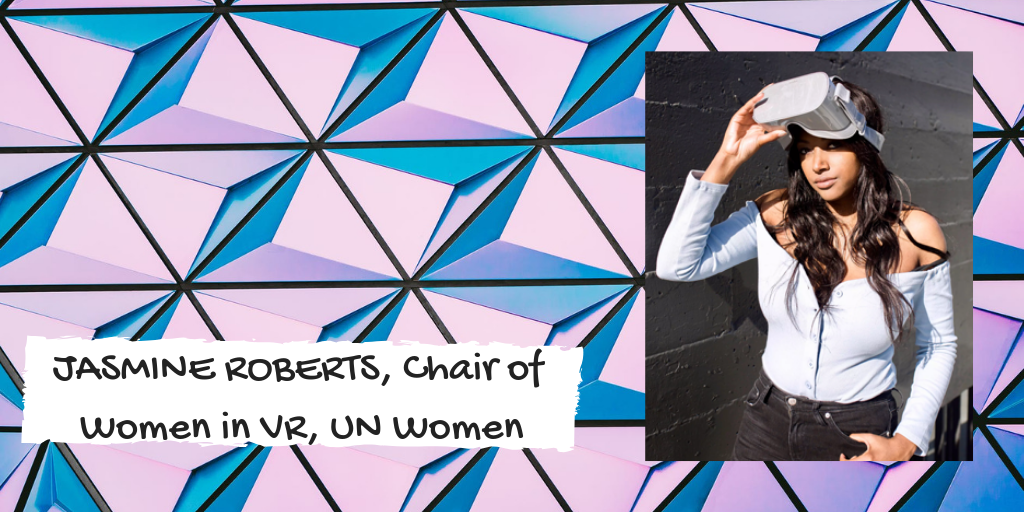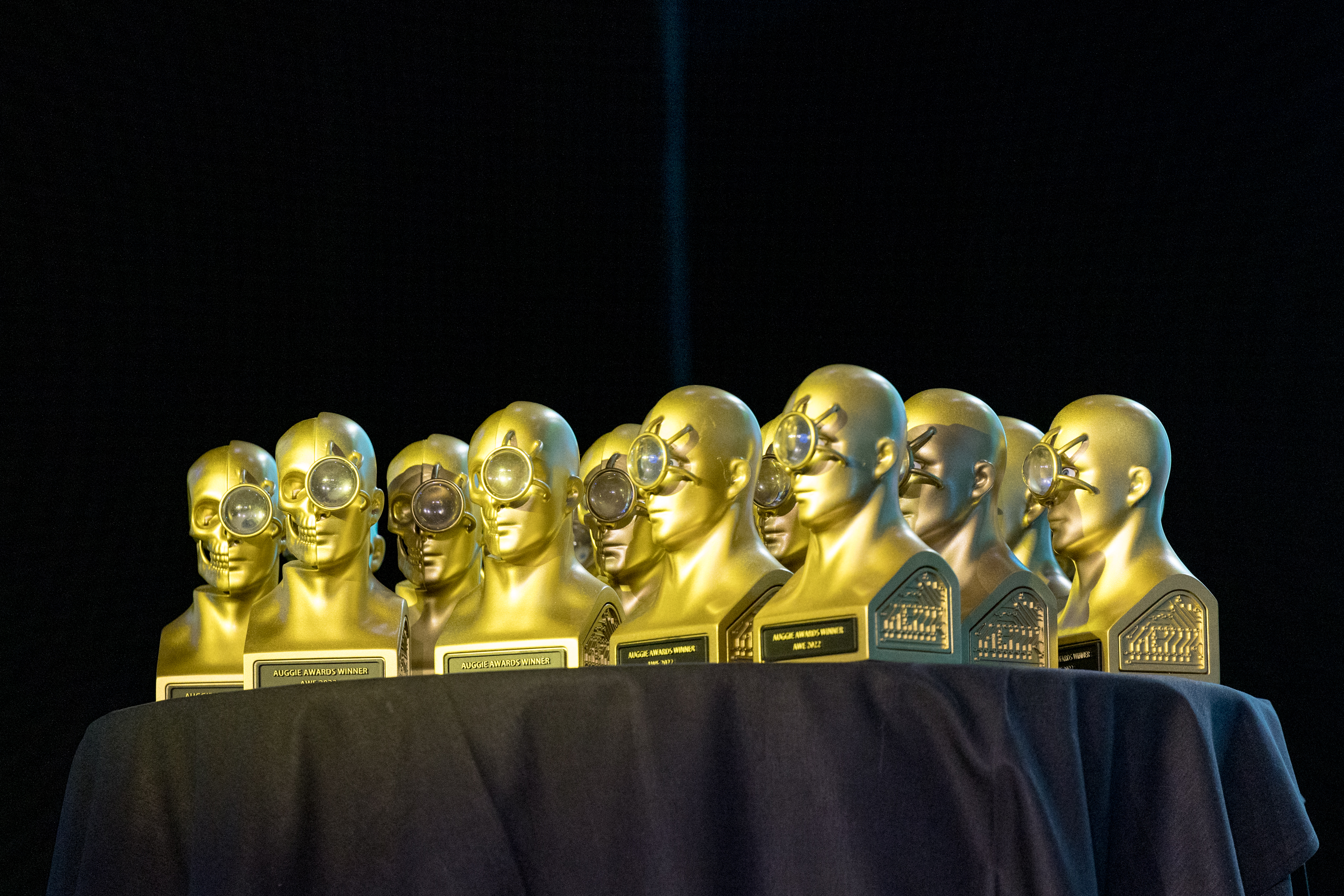When it comes to achieving gender equality, the technology industry is behind the U.S. economy as a whole. Women are paid less, receive less VC funding, and occupy fewer leadership and technical positions compared to men. So, for this Women's History Month, I am interviewing real women working in immersive tech, women who challenge the idea that the tech industry lacks visible female role models. Enjoy!
Emily: To begin, could you provide us with a little background on yourself and your career? What does your job entail and what was your very first encounter with AR/VR?
Jasmine: I am a software engineer, researcher and lecturer who has always had an interest in the physical sciences and technology but also in human cognition--so AR/VR is a natural fit that allowed me to aggregate my interests. My first real experience was the CAVE system in Brown's Computer Graphics Group in 2009. I was interested in developing physical simulations; however, the specific moment that made me officially pivot into the field was seeing 'Waves of Grace' at the United Nations Social Good Summit in 2015. I had been working in optics, graphics and visualization but despite rendered graphics that looked so realistic, virtual reality felt extant. This work evokes a sense of considering people/humanity, not just soulless semiotics.
Most of my work has centered on using 3D data to interpret an environment. I have worked on a myriad of projects ranging from using AR and microscopy for hydroponic systems, scanning the US-Mexico border with LIDAR, and consolidating and re-constructing planetary surface data for NASA, to enabling AR Cloud platforms. Currently, my work focuses are conversational agents and digital humans.
Emily: What is it like as a woman working in AR/VR?
Jasmine: I have been in STEM for all of my adult life, so my perception may be different and a bit normalized. Comparatively, more women are given visibility and platforms than I see in many other technical fields. That is to be lauded.
It's hard to evaluate an objective experience because I cannot honestly remember a day I have not been inundated with new technologies. Seeing as neither of my parents are engineers and considering other gender norms, I was a strange child. At 7, I was breaking and building computers and in 1998 was the first person at my school to have a cellphone and later in 2001 an iPod (cried crocodile tears to get them). I still retain that child-like sense of curiosity. AR/VR is another technology to be enjoyed before it becomes ubiquitous.
Ultimately, being a woman in any branch of tech is intense and fast-paced. It has always been appealing because my mindset is one where I don't like being told 'no'--I am continually questioning and inspired by challenging problems.
Emily: What challenges do you face that your male colleagues or peers don't?
Jasmine: Males benefit from a perceived illusion of competency and are given the benefit of the doubt. This longstanding myth of meritocracy is a hindrance to women. Many men I know are in companies because their friends referred them, yet no matter how skilled women are seen as the "diversity hire," which is an epithet. I have learned that many perceive nepotism as OK but not efforts in balancing gender or racial diversity.
Emily: Have you ever felt judged or overlooked because of your gender?
Jasmine: Of course! There is always an attitude of "there is no way someone who looks like you can do this." I recall explaining to someone before working with them on a computer science project that I have a strong math and physics background, yet they were very surprised when I was able to solve something quickly. Three weeks later they must have forgotten our preliminary coversation. Additionally, I used to attend many hackathons and always found it disheartening when both men and women would overlook me and other women participating, assuming we could not help them with development. Once people know you, that skepticisim dissipates.
Emily: What about the user experience for women; how do the devices fit and perform for women?
Jasmine: Well, let me put it this way: VR is a very intimate technology made by awkward people so not all of these shortcomings are intentional. As evidenced on Twitter, Magic Leap and other AR/VR headsets look wonderful on women. However, VR headsets have gone through many design iterations. The Oculus Rift had issues with coarse Afro hair, but those issues were addressed and mitigated with the Go headset. Companies are making visible improvements. I have also seen complaints about the futile attempt to style hair and apply makeup, go into VR, and then come out presentable. I enjoy the entertaining community discussions about altering hairstyles to accomodate the headsets.
Emily: What is the most critical issue for women in AR/VR?
Jasmine: Lack of funding and lack of true comradery. Lack of funding: Most experiences are women are not receiving the revenue. This is the most important. There is an illusion of funds being given, however. Lack of true comradery: There is a difference in saying you support yourself as a woman versus actually supporting other women.
Emily: Do you believe there is a lack of content for women AR/VR users? Do you know of anything in the pipeline?
Jasmine: There is a dearth of content in general; however, Oculus released a wonderful list on March 6th.
Emily: What is your advice to women working in AR/VR?
Jasmine: To remain humble and not be competitive amongst one another and channel that energy into production. I understand that men may be given the benefit of the doubt, but women still need to put in the work and time. This field is moving rapidly but we need to remain patient and diligent. Many women in this field may have been hurt but we need to take care not to hurt others. If you claim to support women but are self-promoting, not supportive nor providing mentorship to other women, your personal stance needs to be re-evaluated. The difference becomes obvious to others eventually. I have been inspired by Iva Leon, Siciliana Trevino Johnson, Ebony Peay-Ramirez, and Lisa Padilla in their dedication to supporting women and fostering communities. Also thank you to you for uplifting women with this series.
Emily: Thank you for sharing your story with me! What would you like to say to men in the space? What should they be doing to help women in tech?
Jasmine: Be respectful and supportive. Albeit, this isn't easy to practice regardless of gender. Realistically, I wouldn't be where I am today without supportive men. My father was a medical research pathologist and many of his students were women and international, and he was very compassionate towards their issues. I excelled at math and science because until 18, I never perceived a barrier. That developmental stage is integral. It was my male biology, physics and computer science professors who hired me as teaching assistants and encouraged me to apply to graduate school and pursue my line of work. The best mentors and managers I have had have actually been men--one of theme even filed a patent with me last summer!
Emily: What is your greatest hope for the future of AR/VR?
Jasmine: Fostering empathy--reaching a human singularity. There are a lot of critics of the concept of true empathy; empathy is conflated with sympathy. In the current political climate, we refuse to actively listen to one another. We do not understand how to disagree civilly. Empathy is not an instinctive gift of humanity--it has to be learned. Empirically, other animals like elephants have been observed to have an innate empathy for their survival. Humans are unique because the complexity of our emotions encourages creativity and hope yet also propagates negative emotions like fear and anger. AR/VR as an intimate extension can assist in our evolution by transitioning empathy from a tool to a trait.
*Hear Jasmine speak at AWE USA 2019 this May 29-31 in Santa Clara, CA!
Jasmine Roberts, Chair of Women in VR, UN Women
Emily: To begin, could you provide us with a little background on yourself and your career? What does your job entail and what was your very first encounter with AR/VR?
Jasmine: I am a software engineer, researcher and lecturer who has always had an interest in the physical sciences and technology but also in human cognition--so AR/VR is a natural fit that allowed me to aggregate my interests. My first real experience was the CAVE system in Brown's Computer Graphics Group in 2009. I was interested in developing physical simulations; however, the specific moment that made me officially pivot into the field was seeing 'Waves of Grace' at the United Nations Social Good Summit in 2015. I had been working in optics, graphics and visualization but despite rendered graphics that looked so realistic, virtual reality felt extant. This work evokes a sense of considering people/humanity, not just soulless semiotics.
Most of my work has centered on using 3D data to interpret an environment. I have worked on a myriad of projects ranging from using AR and microscopy for hydroponic systems, scanning the US-Mexico border with LIDAR, and consolidating and re-constructing planetary surface data for NASA, to enabling AR Cloud platforms. Currently, my work focuses are conversational agents and digital humans.
Emily: What is it like as a woman working in AR/VR?
Jasmine: I have been in STEM for all of my adult life, so my perception may be different and a bit normalized. Comparatively, more women are given visibility and platforms than I see in many other technical fields. That is to be lauded.
It's hard to evaluate an objective experience because I cannot honestly remember a day I have not been inundated with new technologies. Seeing as neither of my parents are engineers and considering other gender norms, I was a strange child. At 7, I was breaking and building computers and in 1998 was the first person at my school to have a cellphone and later in 2001 an iPod (cried crocodile tears to get them). I still retain that child-like sense of curiosity. AR/VR is another technology to be enjoyed before it becomes ubiquitous.
Ultimately, being a woman in any branch of tech is intense and fast-paced. It has always been appealing because my mindset is one where I don't like being told 'no'--I am continually questioning and inspired by challenging problems.
Emily: What challenges do you face that your male colleagues or peers don't?
Jasmine: Males benefit from a perceived illusion of competency and are given the benefit of the doubt. This longstanding myth of meritocracy is a hindrance to women. Many men I know are in companies because their friends referred them, yet no matter how skilled women are seen as the "diversity hire," which is an epithet. I have learned that many perceive nepotism as OK but not efforts in balancing gender or racial diversity.
Emily: Have you ever felt judged or overlooked because of your gender?
Jasmine: Of course! There is always an attitude of "there is no way someone who looks like you can do this." I recall explaining to someone before working with them on a computer science project that I have a strong math and physics background, yet they were very surprised when I was able to solve something quickly. Three weeks later they must have forgotten our preliminary coversation. Additionally, I used to attend many hackathons and always found it disheartening when both men and women would overlook me and other women participating, assuming we could not help them with development. Once people know you, that skepticisim dissipates.
Emily: What about the user experience for women; how do the devices fit and perform for women?
Jasmine: Well, let me put it this way: VR is a very intimate technology made by awkward people so not all of these shortcomings are intentional. As evidenced on Twitter, Magic Leap and other AR/VR headsets look wonderful on women. However, VR headsets have gone through many design iterations. The Oculus Rift had issues with coarse Afro hair, but those issues were addressed and mitigated with the Go headset. Companies are making visible improvements. I have also seen complaints about the futile attempt to style hair and apply makeup, go into VR, and then come out presentable. I enjoy the entertaining community discussions about altering hairstyles to accomodate the headsets.
Emily: What is the most critical issue for women in AR/VR?
Jasmine: Lack of funding and lack of true comradery. Lack of funding: Most experiences are women are not receiving the revenue. This is the most important. There is an illusion of funds being given, however. Lack of true comradery: There is a difference in saying you support yourself as a woman versus actually supporting other women.
Emily: Do you believe there is a lack of content for women AR/VR users? Do you know of anything in the pipeline?
Jasmine: There is a dearth of content in general; however, Oculus released a wonderful list on March 6th.
Emily: What is your advice to women working in AR/VR?
Jasmine: To remain humble and not be competitive amongst one another and channel that energy into production. I understand that men may be given the benefit of the doubt, but women still need to put in the work and time. This field is moving rapidly but we need to remain patient and diligent. Many women in this field may have been hurt but we need to take care not to hurt others. If you claim to support women but are self-promoting, not supportive nor providing mentorship to other women, your personal stance needs to be re-evaluated. The difference becomes obvious to others eventually. I have been inspired by Iva Leon, Siciliana Trevino Johnson, Ebony Peay-Ramirez, and Lisa Padilla in their dedication to supporting women and fostering communities. Also thank you to you for uplifting women with this series.
Emily: Thank you for sharing your story with me! What would you like to say to men in the space? What should they be doing to help women in tech?
Jasmine: Be respectful and supportive. Albeit, this isn't easy to practice regardless of gender. Realistically, I wouldn't be where I am today without supportive men. My father was a medical research pathologist and many of his students were women and international, and he was very compassionate towards their issues. I excelled at math and science because until 18, I never perceived a barrier. That developmental stage is integral. It was my male biology, physics and computer science professors who hired me as teaching assistants and encouraged me to apply to graduate school and pursue my line of work. The best mentors and managers I have had have actually been men--one of theme even filed a patent with me last summer!
Emily: What is your greatest hope for the future of AR/VR?
Jasmine: Fostering empathy--reaching a human singularity. There are a lot of critics of the concept of true empathy; empathy is conflated with sympathy. In the current political climate, we refuse to actively listen to one another. We do not understand how to disagree civilly. Empathy is not an instinctive gift of humanity--it has to be learned. Empirically, other animals like elephants have been observed to have an innate empathy for their survival. Humans are unique because the complexity of our emotions encourages creativity and hope yet also propagates negative emotions like fear and anger. AR/VR as an intimate extension can assist in our evolution by transitioning empathy from a tool to a trait.
*Hear Jasmine speak at AWE USA 2019 this May 29-31 in Santa Clara, CA!



